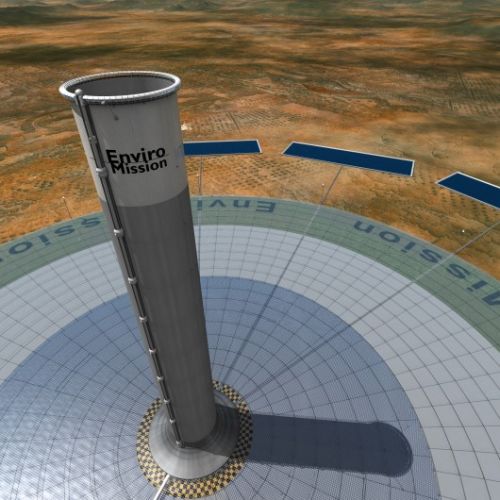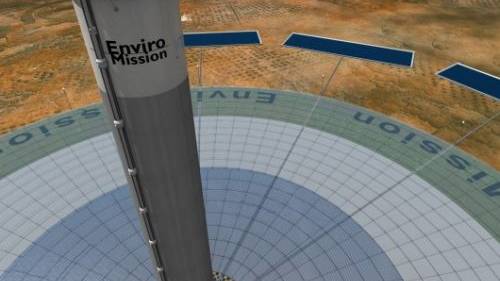Tallest Solar Tower Set for Arizona
Source: ipsnews.net

In the western desert state of Arizona, a company called EnviroMission is planning to build a new solar tower, the first of its kind, an ambitious new way to produce energy with heat from the sun.
When completed in 2015, the tower, located in La Paz County, will be the tallest structure in the United States, and the second tallest in the world. It is the first of two such towers planned by EnviroMission for Arizona.
While it is a solar power source, it does not rely on the same technology as solar panels.
The solar tower has a wide greenhouse at the bottom 4.8 kilometres in diametre, which is heated by the sun. On the principle that hot air rises, the heat then gets sucked into the gigantic 800-metre-high tower, displacing cool air and pushing it up through the tower, causing turbines located just above the base to turn.
Causing turbines to turn is actually the premise of most of today’s most prevalent sources of energy.
For example, most dirty sources of energy like nuclear and coal are simply ways to generate heat to boil water to spin turbines. It is not as if splitting an atom, or burning coal by itself, generates electricity; these technologies are merely ways to create heat.
Video from: YouTube.com
It has become a popular saying among anti-nuclear activists that using nuclear technology to boil water is akin to using a chain saw to slice butter.
Yet, the solar tower is a cleaner, safer way to do the same thing.
The energy from the tower will be enough to power 150,000 homes, and will employ 1,500 Arizonans in the construction phase, with an operational workforce of 30 to 50.
EnviroMission is an Australian company, and it has contracted with U.S.-based companies Hensel Phelps and Faithful and Gould to perform the construction.
The Southern Californian Public Power Authority has agreed to purchase 200 mega-watts of energy from EnviroMission.
The Solar Tower is projected to offset one million tonnes of greenhouse gases per year and to abate the use of up to one billion gallons of potable water annually, water which would have been used in dirtier power generation methods.
"The reality is, Arizona’s a great place to pursue something like this. We’ve met with great support for the technology," Christopher Davey, president of EnviroMission’s U.S. division, told IPS.
"We don’t have the political will in Australia to support renewable technologies right now," Davey said, noting that Spain, on the other hand, operated a smaller prototype of the solar tower in the 1980s.
Among the benefits of pursuing this project in the U.S. are state and federal tax incentives.
In Arizona, "If you build a solar power generation facility, you reduce your real and personal property (machinery and equipment) taxes by 80 percent," Barry Broome, executive director of the Greater Phoenix Economic Council, told IPS. These benefits are on top of federal incentives to support solar power production.
"Arizona is working to position itself as a place to export energy to other markets," Broome said.
Asked why EnviroMission is selling its power to California and not Arizona, Broome said Arizona will eventually want to use some of its own power.
"Now we get to build our industry position out," he said. "You have to be able to build enough solar power to affect your energy sources, so it’s 30 thirty percent of your energy."
"It’s an incredibly high tower," Broome noted. "It took us a while to get comfortable. That’s part of being in the world of new technology."
Davey explained the solar tower and how it works in further detail.
"We capture heat beneath the large greenhouse, a collector area. The roof of that is slightly pitched. It’s 10 feet off the ground at the outside, and 50 feet off the ground in the centre. So it would naturally rise," Davey said.
"The difference in temperature when it’s cold at the top and hot at the bottom - it’s the pressure drop that is making them (the turbines) spin," he said.
Davey noted that the solar tower captures not only direct heat from the sun, but ultraviolet rays, which would even be present on a cloudy, rainy, or cool day.
Typical solar and wind power methods, on the other hand, are not always reliable, because they can be interfered with by clouds, or merely a slowing-down of the winds, respectively.
Other benefits of the solar tower are that it works on a temperature differential, not absolute temperature, so it works in any weather; the heat of the day warms up the ground enough so that the tower works at night as well; it requires no feed stock such as coal or uranium; it requires no water; it emits absolutely no pollution, other than hot air; and requires very little maintenance, except to service the turbines.
EnviroMission hopes that it can built at least 15 solar towers in the U.S. over the next 20 years.
Article from: ipsnews.net
Image: The Solar Tower is projected to offset one million tonnes of greenhouse gases per year and to abate the use of up to one billion gallons of water.
Credit:Courtesy of Enviromission






















